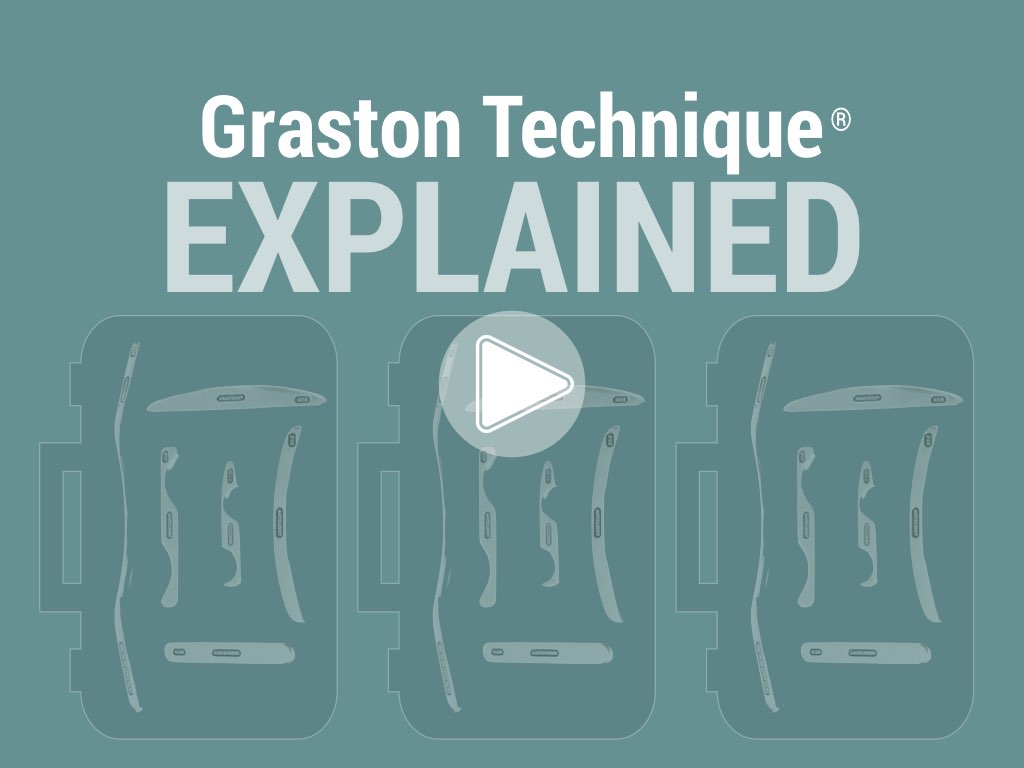Soft Tissue Therapy Treatment Near Me
What is the Graston Technique?
The Graston Technique® is manual therapy known as soft-tissue instrument-assisted mobilization, used by physical therapists and those certified in administering the Graston Technique. It involves the use of specially-designed stainless steel instruments to detect and treat areas with soft tissue fibrosis or chronic inflammation. Graston Technique therapy is integrated into a therapeutic regimen that includes stretching, strengthening, and other rehabilitative exercises.
How does Graston Technique therapy work?
Using evidence-based manual therapy, the Graston Technique involves physical therapists using specialized stainless steel instruments to gently rub and massage targeted areas. This method pinpoints restricted zones and softens scar tissue. Combined with therapeutic exercises, this therapy creates pain-free movement and improves function. It successfully treats chronic, acute, or post-surgical soft-tissue injuries.
One of our Release PT Graston Technique certified physical therapists will scan and treat the specific area. They will rub the affected area with a handheld stainless steel instrument, using Graston massage techniques for about 30 to 60 seconds per area treated.
What are the benefits of Graston Technique therapy?
The primary benefit of Graston Technique therapy is relief. It is a versatile treatment that can be used for any soft tissue injury. It is also used to treat any muscle pain, aches, or restricted range of motion. Graston Technique therapy has resolved issues for patients that caused them to live with pain for years, sometimes decades. Other benefits include:
- Decreased Treatment Time and Faster Rehabilitation: Graston Technique therapy often leads to quicker healing and a shorter overall recovery period.
- Identification of Issues: The instruments scan and identify areas of fibrotic tissue, which cause pain, stiffness, and reduced mobility.
- Breaking Down Scar Tissue: This technique aims to break down scar tissue and fascial restrictions, associated with soft tissue trauma, like strained muscles, sprained ligaments, or after surgery.
- Promoting Healing: By introducing controlled microtrauma to affected soft tissue, the Graston Technique stimulates a local inflammatory response, which can lead to the remodeling of affected soft tissues, enhancing healing. It also reduces the need for anti-inflammatory medications. It resolves many chronic conditions which were previously thought to be permanent.
- Increasing Range of Motion: It helps in increasing range of motion and decreasing overall pain associated with movement.
- Common Use Cases: This technique treats the following conditions: tendonitis, carpal tunnel syndrome, back and neck pain, knee pain, foot pain, shoulder pain. fibromyalgia, and other soft tissue conditions. tennis or golfer’s elbow, Myofascial pain syndrome, shin splints, trigger finger, post-surgical joint replacements, and post-mastectomy or cesarean scarring.
- Reduces Incidence of Re-injury: By restoring the health and function of soft tissues, the Graston Technique reduces the likelihood of future injuries in those areas.
What conditions can be treated with Graston Technique?
Graston Technique can be used to treat any movement system dysfunction that has been determined to have a soft tissue component. Graston therapy can effectively and efficiently address soft tissue lesions and fascial restrictions while treating acute and chronic conditions, including:
- carpal tunnel syndrome
- neck pain
- fibromyalgia
- tennis elbow / golfer's elbow
- back pain
- myofascial pain syndromes
- knee pain
- foot pain
- post-surgical joint replacements
- shoulder pain
- scar tissue / post-surgical scars
- shin splints
- trigger finger
- post-mastectomy scarring
- caesarean scarring
What conditions can be treated with Graston Technique?
Graston Technique can be used to treat any movement system dysfunction that has been determined to have a soft tissue component. Graston therapy can effectively and efficiently address soft tissue lesions and fascial restrictions while treating acute and chronic conditions, including:
- carpal tunnel syndrome
- neck pain
- fibromyalgia
- tennis elbow
- golfer's elbow
- back pain
- myofascial pain syndromes
- knee pain
- foot pain
- post-surgical joint replacements
- shoulder pain
- scar tissue / post-surgical scars
- shin splints
- trigger finger
- post-mastectomy scarring
- caesarean scarring
What kind of results does Graston Technique produce?
Historically, the Graston Technique has had positive outcomes in 75-90 percent of all conditions treated. It is equally effective in restoring function to acute and chronic injuries, pre- and post-surgical patients and maintaining optimal range of motion.
How often should you do Graston Technique treatments?
The frequency of Graston treatments depends on your specific condition and response to therapy. Treatments begin with 1-2 sessions per week initially but can be adjusted based on progress. Ongoing treatment might be necessary and later shift to maintenance with less frequent visits. A personalized treatment plan will be developed by your Release physical therapist to determine the most effective treatment schedule for your case.
Will Graston Technique affect my daily activities?
Patients that have progressed beyond the acute stages of inflammation and repair are often encouraged to resume a pain-free level of activity and exercise with the modifications that are determined by their Graston Technique certified physical therapist. Graston Technique is designed to be implemented with appropriate therapeutic exercises and activities to achieve an ideal outcome.
What happens before my Graston Technique treatment?
Prior to an appointment at Release Physical Therapy with a Graston Technique certified and trained physical therapist, patients are advised to complete five minutes of cardiovascular activity, such as riding a stationary bike or walking on a treadmill. A heat treatment may first be applied to the injured area to warm up the soft tissue before Graston Technique is administered.
What can I expect during a Graston Technique treatment session?
A Graston Technique certified physical therapist will first utilize the appropriate instruments to scan, then treat, the affected area. Treatment generally consists of the physical therapist rubbing the affected area(s) with the handheld stainless steel instruments, using very specific, calculated massage techniques. Treatment time is usually 30 to 60 seconds per area treated. It is common for patients to experience some discomfort during the procedure.
What should I expect after a Graston Technique treatment session?
Many patients have reported increased range of motion and reduced pain after the first treatment. You may experience soreness, bruising or see small red dots (called petechiae) over the area treated. If any soreness is felt after the procedure, icing the treated area for 15 to 20 minutes following the treatment may ease the discomfort. Your physical therapist will design an exercise and/or stretching program to be used in conjunction with the Graston treatments to maximize effectiveness.
What kind of results does the Graston Technique produce?
The Graston Technique has historically demonstrated successful outcomes in about 75-90% of all conditions it has treated. It has proven equally effective in restoring function to both acute and chronic injuries, as well as for pre- and post-surgical patients, and for maintaining range of motion.
How should I prepare for a Graston Technique treatment?
Before your appointment at Release Physical Therapy with a Graston Technique certified therapist, prepare with a brief five-minute cardiovascular activity, like stationary biking or walking on a treadmill. Additionally, a heat treatment may be used to warm up the injured area prior to the Graston Technique.
Will Graston Technique affect my daily activities?
Patients that have progressed beyond the acute stages of inflammation and repair are often encouraged to resume a pain-free level of activity and exercise with the modifications that are determined by their Graston Technique certified physical therapist. Graston Technique is designed to be implemented with appropriate therapeutic exercises and activities to achieve an ideal outcome.
How effective is the Graston Technique treatment?
For over 25 years, the Graston Technique has been helping patients recover and rehabilitate successfully with soft tissue therapy. This technique is now standard practice in numerous universities, hospital-based outpatient facilities, and industrial on-site treatment centers and this treatment is a favorite of many athletes in the NFL, NBA, MLB, and even Olympian teams. At Release PT, we take pride in the many patients who have experienced pain-free relief and recovery due to our applications of the Grayson Technique in our Washington D.C. practice.
What can I expect during a Graston Technique treatment session?
A Graston Technique certified physical therapist will first utilize the appropriate instruments to scan, then treat, the affected area. Treatment generally consists of the physical therapist rubbing the affected area(s) with the handheld stainless steel instruments, using very specific, calculated massage techniques. Treatment time is usually 30 to 60 seconds per area treated. It is common for patients to experience some discomfort during the procedure.
What should I expect after a Graston Technique treatment session?
Many patients have reported increased range of motion and reduced pain after the first treatment. You may experience soreness, bruising or see small red dots (called petechiae) over the area treated. If any soreness is felt after the procedure, icing the treated area for 15 to 20 minutes following the treatment may ease the discomfort. Your physical therapist will design an exercise and/or stretching program to be used in conjunction with the Graston treatments to maximize effectiveness.
How long does it take for Graston Technique treatments to work?
Patients may begin noticing improvements within a few treatment sessions. But, significant and lasting benefits become even more evident after several weeks of consistent treatment. Patients may get faster relief within a few sessions when they have been suffering from acute conditions. Those with chronic conditions may require a longer treatment period to achieve improvements. It's important to maintain realistic expectations and understand that the healing process can be gradual.
The effectiveness of the Graston Technique may also be influenced by the patient's adherence to the treatment plan developed by our physical therapy team, which may include exercises, stretches, and other therapies alongside the Graston treatments. Consistent follow-up and a holistic approach to treatment lead to the most successful outcomes.
Is Graston Technique treatment safe for everyone?
The Graston Technique is generally safe but may not be suitable for everyone. It should be used with caution or avoided in advanced diabetes, certain skin conditions, blood clotting disorders, compromised immune systems, or cancer. Pregnant women and those with implants or healing fractures should consult their healthcare provider before undergoing this treatment. Special considerations are also needed for children, the elderly, and those with acute injuries. Anyone considering the Graston Technique should first seek advice from their healthcare provider to ensure it is appropriate for their specific health situation.
If you believe our Graston Technique therapy could be beneficial and you have the desire to relieve your chronic pain and achieve restorative and therapeutic healing in your soft tissues, call us today at Release Physical Therapy and schedule an appointment with us to explore your options for improved health using the Graston Technique.
Certified Graston Technique Providers in Washington, D.C.
Only certified and properly trained clinicians can safely and effectively provide Graston Technique treatment. All physical therapists at Release Physical therapy are certified and extensively trained in the technique. If you think you may benefit from Graston Technique therapy, call our office at Release Physical Therapy to speak with one of our certified physical therapists or request an appointment today.







